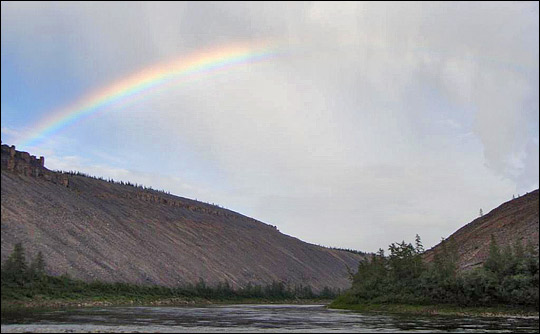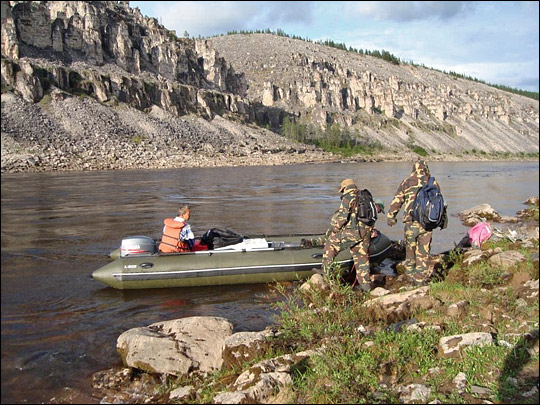

|
|
|||
July 16–17From Taymyrskiy Region, Siberia 10:45 AM USZ6S (10:45 PM EDT)
From Dr. RansonThis part of Siberia is incredibly beautiful. We’re traveling into the Siberian Traps, ancient basaltic mountains. These mountains add tremendous scenic value to the trip. But they also add a lot of serious challenges to our work. Our new camp, where we set up on Tuesday, is right where a smaller tributary river flows into the Kotuykan. When we look downriver, we can see the Kotuykan flowing swiftly between the stark mountains. Larch trees grow well on the top of the mountains, so they appear green and soft. The sides of the mountains are a real contrast. They are dark and sheer, made up of crumbling rock. In some places, where the rock is more weather-resistant, there are formations that look like columns and fortresses that jut out of the side of the mountain. The crumbling rock is evidence of the power of the weather, in particular the strength of the freeze-thaw cycle. I can see the top layer of the hardened basaltic lava and can also see where this basalt is breaking away. When the rock breaks off the mountain, it is sharp and jagged. That’s what’s on the crumbling hillsides and in tonight’s campsite of ours, too—pointed rocks. Eventually the rains will roll the rocks into the river, and then bigger rains will roll them along towards the sea, rubbing off some of the sharp edges as they go along. Eventually they will be rolled into the sea. As the mountains are worn away, the sea bottom slowly rises. These mountains are ancient, but the forces of nature are slowly, slowly, slowly taking them down and leveling the entire region. Yesterday started out nice and dry—a pleasant thing, since we had to break camp and move downriver. Just as soon as we got into our boats and began to move, it just poured down on us. We had rain all day, until we prepared to pull to shore. Then the skies began to clear. As we set up our camp, I heard someone tell us to look downriver. A gorgeous, huge rainbow stretched over the river. With the green trees, the dark mountains, the blue river, and the clearing sky as background, the rainbow was an amazing thing to see. |
|||

|
|||
|
It was nice to have a peaceful day yesterday, because today was much more exciting. From our maps, we knew that we’d have a tough time getting to our GLAS points to do our measurements today. There were a lot of points, but they were on a sheer-sided mountain. We spent a good deal of time discussing the best routes up the mountain and came up with one plan and two possible alternatives. We knew this was not going to be a stroll, but would be a real challenge. We were more right than we imagined! As usual, our measurement sites were across the river from camp. We asked Mukhtar, who was staying to work with his colleagues on their studies in the mountains on the camp side of the river, to ferry us across. He took us where we asked: near the entry of a small, steep-sided canyon. We believed that near there the mountain’s edge would flatten enough to be safely climbable. |
At the end of a long day’s journey downriver in the rain, the skies cleared just in time to set up camp. The appearance of a rainbow was a special treat for tired expedition members. The river is the Kotuykan, a day’s journey north of where it meets the larger Kotuy River. (Photograph by Jon Ranson.) |
||

|
|||
|
As we walked down the canyon, we came across a beautiful waterfall. But the walls didn’t really diminish. It was all steep and covered with loose, sharp, basaltic rock and debris. Eventually we found a spot that appeared to be passable, and we decided to climb it. It was, um, challenging and … well, it had some exciting spots, too. It was a long scramble, with the rocks underfoot often sliding a few inches or more down the mountain as we climbed. It was hard to get forward motion. There was one spot where I was so very, very happy to feel my slow downward slide stop. Where I stopped was pretty close to an edge. Beyond the edge was about a twenty-foot drop off. Fortunately, no one needed to examine any drop-offs in a personal way. Although it was a tough climb, we all made it to the top just fine. The rest of the day was spent relatively serenely, measuring plots and working down slope. It turned out that the hard climb was very worthwhile; we were able to measure about 15 plots today. We’re getting a lot of truly good data. I can’t wait to get back and begin to analyze what we’ve gathered. We did have a little more excitement, because the mountainside was steep and loose near the river. At least we were heading down hill so the scramble wasn’t nearly as hard. But it turns out that we ended up about a mile and a half downriver from our rendezvous point. We elected Ross to walk upriver, find the boat and bring the ferry downriver to us. It’s such a joy, I’m sure, to be the newest man on an expedition—you get all the fun jobs. Ross soon found Mukhtar patiently waiting and brought him to us. Soon we were back at our camp. It’s our home sweet home, where the stones are all jagged and range in size from ping pong balls to a couple of microwaves. But how wonderful to be back and get a chance to relax and have a meal. And then—it began to rain. |
The expedition’s camp is on the opposite side of the river from the study sites. The team uses the largest boat on the expedition, which has a 40-horsepower motor, to ferry people and gear. Paul Montesano and Guoqing Sun have just disembarked at their study site, while Mukhtar Naurzbaev prepares to return the boat to camp for the day. (Photograph by Jon Ranson.) |
||